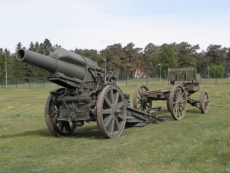
The period 1845-1902 was a refining period of history for the nature of warfare which can primarily be seen through technical and ideological change. Technological changes within this period were especially exponential coinciding with the final years of the industrial revolution (1750-1850) which lead to innovations of warfare such as breach loading Artillery and explosive shells. The later nineteenth century saw gunpowder undermine the roles of cavalry and sabres which had often been favoured in ‘old’ Napoleonic style tactics which involved walking at a steady pace towards the enemy line and which many armies still adhered to now equipped with modern weapons of the time. Therefore with the introduction of faster firing guns, in particular the use of rifling and explosive shells, these ancient tactics were fruitless and lead only to inevitable slaughter, illustrated in the American Civil War where the North lost an estimated 17,000 men at the battle of Chancellorsville.
The ability to kill as many of your opponents in as short a time as possible is the ultimate aim in any war thus the revolutionary changes to weaponry is such a key aspect of the changes of warfare 1845-1902. Whereas prior to this period armies had quite simply opposed one another on a battlefield and fought savagely with a limited degree of strategy, the introduction of deadly weaponry able to surmount horrendous death tolls in minutes forced an increasing number of wars of attrition. The infamous ‘Charge of the Light Brigade’ at the Battle of Balaklava (1854) in the Crimean War (1854-6) and much of the latter American Civil War (1861-65) proved the ineffectiveness of cavalry and old Napoleonic style tactics in the face of powerful new weaponry such as the Gatling Gun which effectively fired as a machine gun though someone was required to crank the lever. Individual firearms in this period saw the rifle usurp the standard issue flintlock musket which meant faster and more accurate firing for the individual soldier which was especially useful in the standard line formation adopted in the U.S Civil War. Furthermore, the innovative Prussians (modern day Germany) single handedly advanced warfare in mainland Europe when they introduced the deadly Krupp Artillery, a key weapon that demonstrated the superiority of breech-loaded steel cannon (which meant you could load the shell from the back of the gun thus meaning you can fire in shorter intervals) over muzzle-loaded brass. Also, although the French Chassepot rifle outweighed the German Dreyse Needle Gun, the Krupp artillery’s superior range and firepower won the Prussians the war and proved highly effective against the French infantry at the battles of Wissembourg and Gravelotte as well as allowing the Prussians to fire on Paris without ever capturing the French capital.
However, the period 1845-1902 saw changes not only for land armies but also for naval warfare which served to further broaden the bloody theatre of war in this period. Perhaps most iconic are the famous Ironclads HMS Warrior (Britain) and La Gloire (France), developed as a result of the vulnerability of wooden warships to explosive or incendiary shells. The first meeting of two Ironclads in combat was The Battle of Hampton Roads (1862) though their hulls were so strong that neither boat could damage the other and thus they were forced to retreat. It was only five years later however that these innovative ships were usurped by the fearsome Dreadnought though these revolutionary warships did not effectively come into play until The First World War. Ultimately the two world wars saw the most drastic changes in the nature of warfare but the late 1800s, which are often forgotten, are still an incredibly interesting period in the history of warfare. It was a blooming period for colonial Western Empires including Britain, France, Germany and the Netherlands and the isolationist US also saw many industrial innovations in this time. This period paved the way for the first total war some decades later in the early 1900s.
IMAGE: http://coldwarsites.net/wp-content/timthumb/timthumb.php?src=/wp-content/files_mf/p5141530www.jpg&w=584) - Krupp Artilery, a deadly early German artillery that revolutionised the late 1800s and showed the potential for more distant styles of warfare. Indeed artillery was used endlessly in the First World War 1914-1918.

0 Comment:
Be the first one to comment on this article.